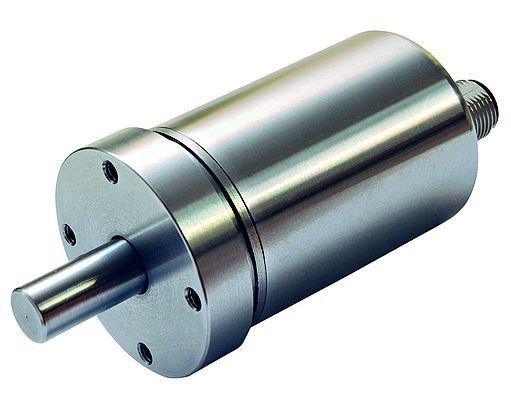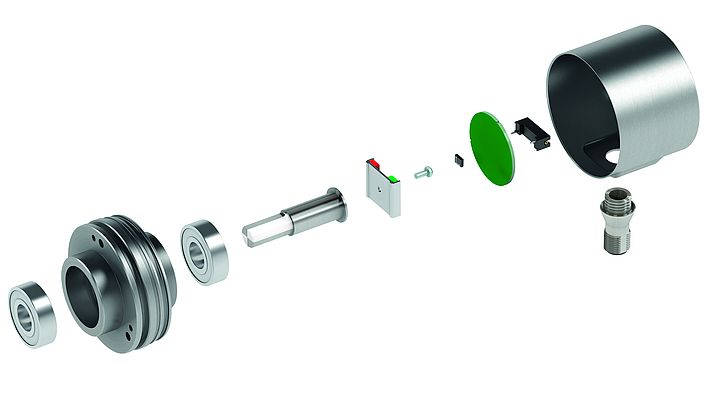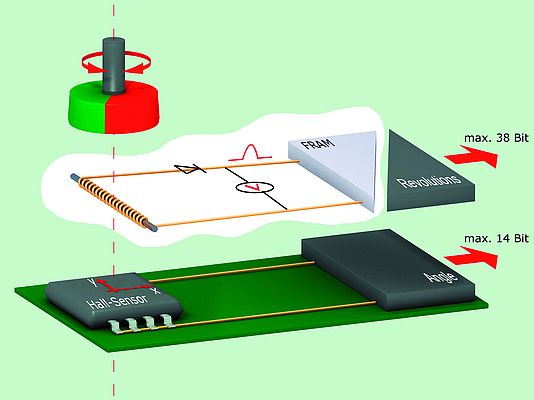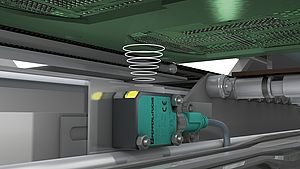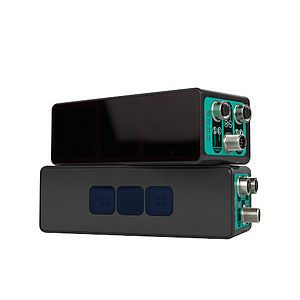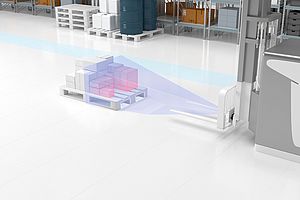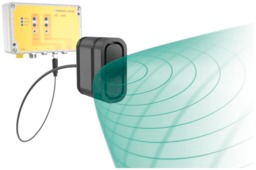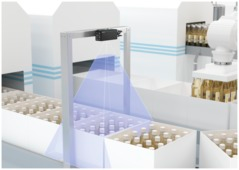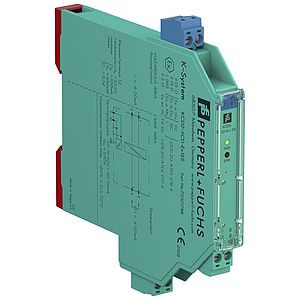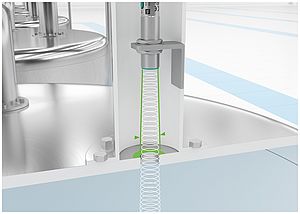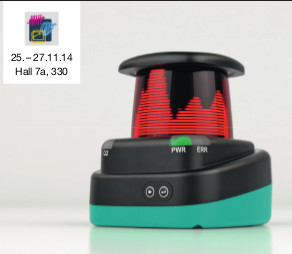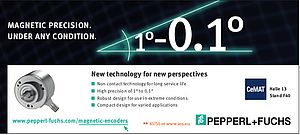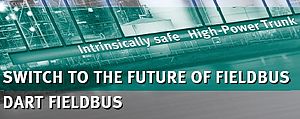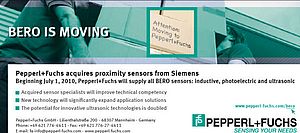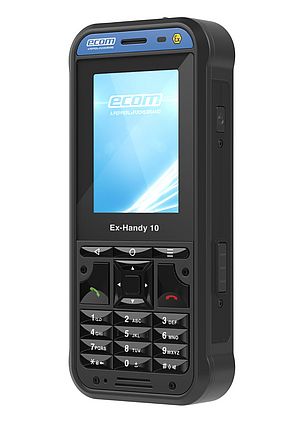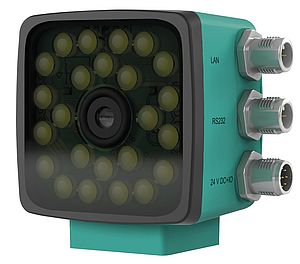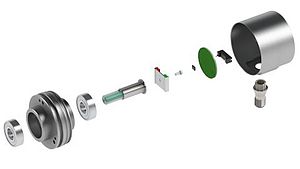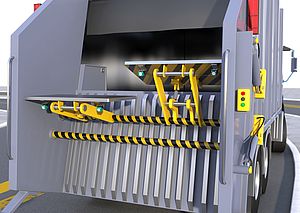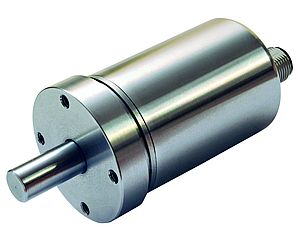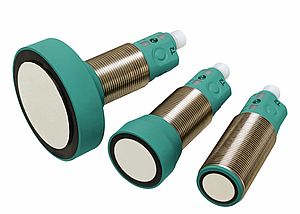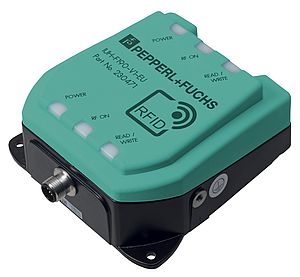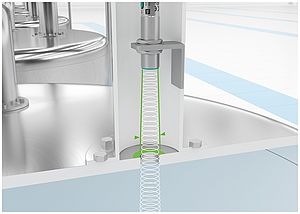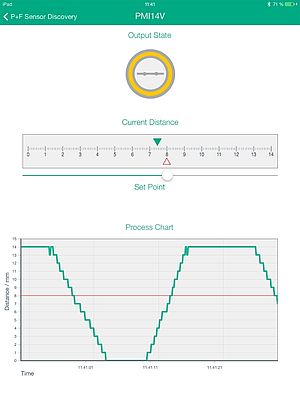The new generation of magnetic absolute rotary encoders sees Pepperl+Fuchs combine, at the highest technical level, the attributes of magnetic field technology with features that were previously only available with optical rotary encoders. The new 0.1°-class magnetic rotary encoders complete the product range of standard mounted encoders. Users will find the optimum solution to meet any requirement in three newly defined accuracy classes of up to 1°, 0.1°, and 0.01°.
Rotary encoders are used to record physical variables such as rotational speed, speed, acceleration, or the paths and positions of moving components. They transform the actual value of a mechanical variable into electric signals that can be evaluated by counters, tachometers, programmable logic controllers, and industrial PCs. In addition to rotary movements, linear movements can be recorded using spindles, gear racks, measuring wheels, or cable pulls. For this reason, rotary encoders can be found in today's standard motion sensors in virtually all areas of factory automation, as well as general machine engineering and plant engineering. The typical areas of application range from the conveying, handling, and packaging industry to the tool machines and testers, and much more. Other applications include commercial vehicles or mobile equipment, and energy generation plants such as wind turbines.
The areas of applications may be varied, but so are the various requirements demanded of rotary encoder features and properties. In the first instance, users are focused on achieving the level of accuracy, resolution, and dynamics required for the respective application. Secondly, physical factors such as robustness, the amount of maintenance required, durability, or resistance to environmental influences including dirt, shocks, humidity, temperatures, etc. play a crucial role. Last but not least, the size of a rotary encoder can also be a key factor. For these reasons, the market has seen a variety of rotary encoder technologies developed, which offer varying levels of performance in terms of the optical, inductive, or magnetic detection principles used.
Solutions used to date
Rotary encoders based on the optical detection principle are generally used for applications that require optimum dynamics and accuracy, such as CNC processing machines. Pepperl+Fuchs provides these rotary encoders in the 0.01° accuracy class. High-end multiturn absolute rotary encoders achieve total resolutions of up to 30 bits and accuracy levels of up to 0.005°. It is not possible to achieve this performance data using other detection principles. However, high loads caused by tough operating conditions and ambient conditions impose a significant technological strain on the sensors. Rotary encoders based on a magnetic detection principle are much more resistant to these kinds of influences. In industrial use, these kinds of rotary encoders are not affected by contamination caused by dust, metal chips, oil, aggressive emulsions, or influences such as high temperatures, vibrations, shocks, etc. The solutions used to date in the field of absolute rotary encoders offer accuracy levels of approx. 1° to 0.5° and a maximum resolution of 12 bits. Dynamics, in terms of cycle times, is over 600 µs. These rotary encoder solutions from the 1° accuracy class are therefore used in applications where high operational loads or extreme environmental influences are present.
The performance data of magnetic rotary encoders available to date has been more than sufficient for a host of application areas. However, working in an extremely broad spectrum has meant that developers have had to make compromises. On the one hand, they required the robustness of magnetic field technology, while on the other hand they required greater accuracy. "It is an area of conflict that, even in manufacturing automation and general machine engineering, is becoming increasingly wide against a backdrop of more challenging ambient conditions with faster processes and growing demands on process reliability," adds Stefan Horvatic, the responsible product manager at Pepperl+Fuchs Drehgeber GmbH.
Going beyond previous limits
Thanks to innovative magnetic field technology, Pepperl+Fuchs has now developed absolute rotary encoders that meet these requirements precisely. Going beyond the limits of what was previously technologically feasible, these encoders combine the robustness of magnetic rotary encoders with a high level of precision and dynamics. Measuring accuracies of up to 0.08°, a multiturn resolution of up to 39 bits, and dynamics of < 80 µs in terms of the cycle time all speak for themselves. "We have primarily been able to develop magnetic rotary encoders by using innovative electronics and high-precision manufacturing methods," explains Horvatic. In addition to the latest Hall sensors and sophisticated magnet technology, special software adaptations have been used to achieve the outstanding performance figures.
An integrated product range
The magnetic absolute rotary encoders for the new 0.1° accuracy class cover a wide range of challenging applications, which require both high levels of precision and dynamics as well as a particular level of robustness in tough operating conditions. By developing these rotary encoders, Pepperl+Fuchs is defining a new top-of-the-line class of magnetic rotary encoders that, in future, will be offered as industry-standard mounted devices with a diameter of 58 millimeters. "In addition to their physical and technological benefits, magnetic rotary encoders are very compact, which is why rotary encoders from the tried-and-tested 1° accuracy class have been used for years. Now there are rotary encoders from the new 0.1° class in mounted housings of 36 millimeters in diameter as well," added Horvatic. However, for those users who now require even greater accuracy levels, the optical encoders from the 0.01° class will provide the right solution. Pepperl+Fuchs offers an integrated portfolio using a standard mounted design, from which users can find the perfect solution for every application, without having to make any compromises.
Robust technology
Absolute rotary encoders based on a magnetic detection principle have featured in the Pepperl+Fuchs product range for some years now. They use a two-axis Hall sensor, which generates a sine or cosine signal via a rotating magnetic field. This signal is processed via an internal processor, such that the process value is identical to the output value of an absolute rotary encoder based on optical detection. An additional Wiegand sensor converts these singleturn rotary encoders into multiturn absolute rotary encoders. A permanent magnetic field that rotates via the Wiegand sensor generates a change in the direction of the magnetic field in the core of the Wiegand sensor. In turn, this process generates an induction voltage in the coil wrapped around the sensor. Energy is therefore always available during a change in the direction of the magnetic field, i.e., twice on each revolution. This is used to electronically count revolutions and supply power to the electronics. An internal battery for supplying power to the electronics is therefore no longer required. The rotary encoders supplied by Pepperl+Fuchs are therefore not affected by voltage failures. No data is lost and all position values are available after rebooting.
The particular benefit offered by magnetic rotary encoders is that they are noncontact and therefore wear-free. Such an ability is what makes this rotary encoder far superior when used in robust conditions, and simultaneously reduces maintenance and service work. In addition, this technology enables rotary encoders to be created in small construction volumes. Last but not least, this sophisticated magnetic field technology even fits in compact housings only 36 millimeters in diameter.


